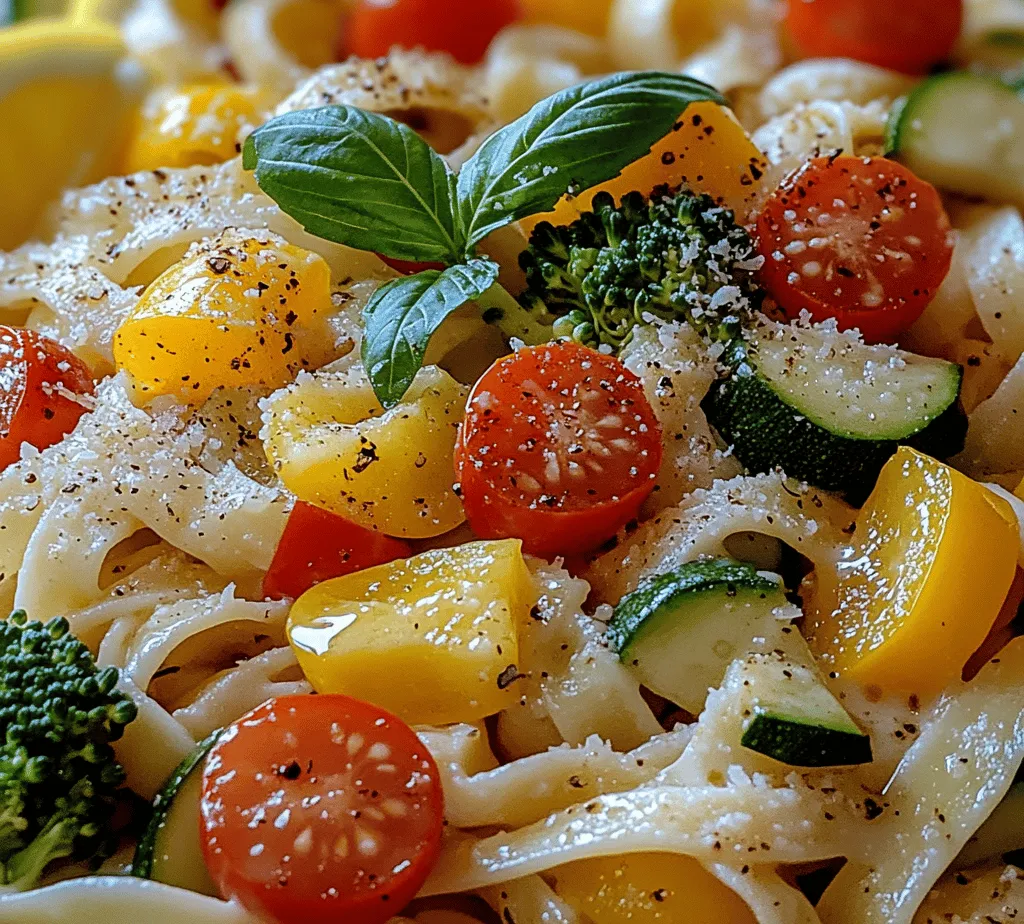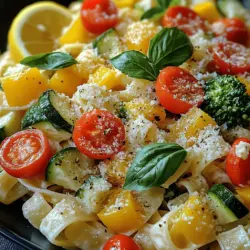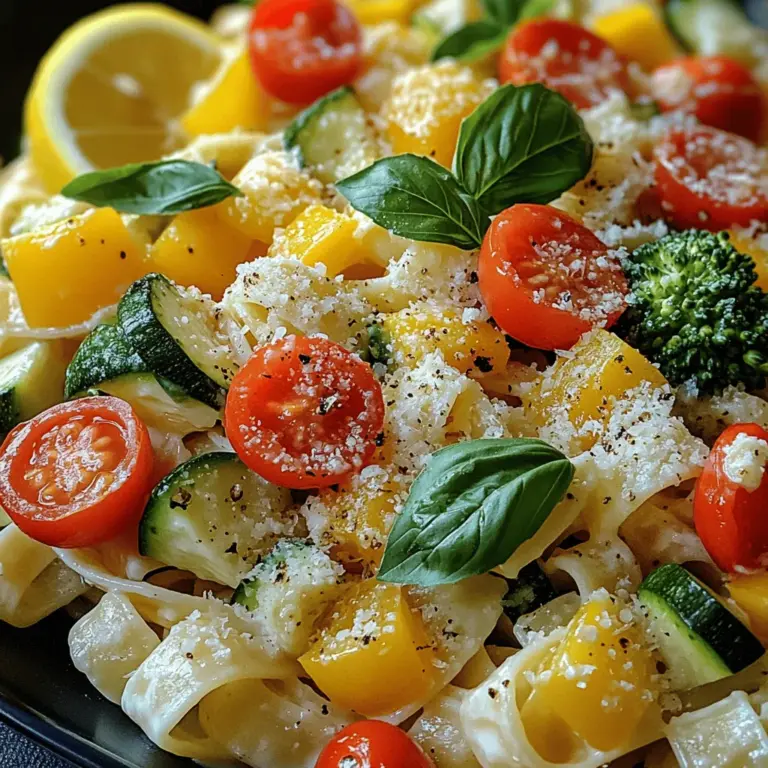Introduction
As the chill of winter fades and the vibrant colors of spring emerge, there’s no better way to celebrate the season than with a dish that embodies freshness and vitality. Enter Pasta Primavera, a delightful Italian recipe that showcases the best of seasonal produce through a medley of fresh vegetables and al dente pasta. This dish, which translates to “Spring Pasta,” is not just a meal; it’s a culinary celebration of the season’s bounty, making it a popular choice for family dinners, gatherings, and even festive occasions.
Pasta Primavera appeals to both the eye and the palate, offering a feast of colors and flavors that reflect the essence of spring. The lightness of the dish, combined with the crispness of freshly harvested vegetables, creates a symphony of taste that is as satisfying as it is nutritious. Whether you are a busy parent looking for a quick weeknight dinner or a host planning a spring gathering, this recipe is perfect for anyone who wants to indulge in a healthy, colorful, and easy-to-make meal.
In this article, we will delve deeper into the historical context and evolution of Pasta Primavera, explore the key ingredients that make this dish a standout, and guide you through the cooking method to help you create your own Vibrant Spring Delight.
Understanding Pasta Primavera
Pasta Primavera has a rich history that dates back to the 1970s when it emerged as a signature dish in Italian-American cuisine. It’s believed that the dish was created by chefs in New York, who sought to highlight the fresh produce available during the spring months. Unlike traditional pasta dishes that often feature rich sauces, Pasta Primavera emphasizes the natural flavors and textures of vegetables, making it a lighter, healthier option.
Over the years, the recipe has evolved, with countless adaptations appearing in homes and restaurants around the world. From the original blend of vegetables to contemporary variations that incorporate different pasta types, sauces, and even proteins, Pasta Primavera continues to inspire creativity in the kitchen. The essence of the dish, however, remains unchanged: it is a celebration of seasonal ingredients that evoke the freshness of spring.
The importance of using seasonal ingredients cannot be overstated when making Pasta Primavera. The dish thrives on the quality of the vegetables used, which is why it’s essential to choose fresh, locally sourced produce. Not only do seasonal ingredients enhance the flavors of the dish, but they also provide numerous health benefits, ensuring that your meal is as nutritious as it is delicious.
Ingredients Breakdown
To create a mouthwatering Pasta Primavera, it’s crucial to use a variety of fresh ingredients that contribute to both flavor and nutrition. Below is an overview of the main ingredients used in this recipe, along with their health benefits.
– Pasta: The foundation of any Pasta Primavera, pasta provides carbohydrates, which are essential for energy. Opt for whole-grain or gluten-free varieties if you prefer a healthier option or have dietary restrictions.
– Olive Oil: A staple in Mediterranean cuisine, olive oil is rich in healthy fats that provide flavor and aid in the absorption of fat-soluble vitamins. It also has anti-inflammatory properties, making it a heart-healthy choice.
– Zucchini and Yellow Squash: These low-calorie, nutrient-rich vegetables are packed with vitamins and minerals. They add a mild yet satisfying flavor and a lovely crunch to the dish.
– Bell Peppers: Available in various colors, bell peppers are loaded with vitamins A and C, as well as antioxidants. Their sweetness and crunch elevate the overall taste profile of the dish.
– Cherry Tomatoes: Sweet and juicy, cherry tomatoes bring a burst of flavor to Pasta Primavera. They are also a great source of vitamins C and K, as well as lycopene, an antioxidant linked to many health benefits.
– Broccoli: This nutrient powerhouse is rich in fiber, vitamins C and K, and various antioxidants. Adding broccoli not only enhances the nutritional value of the dish but also contributes a beautiful green color.
– Garlic: A must-have for flavor, garlic also offers numerous health benefits, including anti-inflammatory and antibacterial properties. Its aromatic qualities can elevate the taste of any dish.
– Parmesan Cheese: While optional, a sprinkle of Parmesan cheese adds a touch of richness and protein to Pasta Primavera. It enhances the overall flavor without overwhelming the lightness of the dish.
– Optional Ingredients: For those who enjoy a bit of heat, consider adding red pepper flakes to your Pasta Primavera. This simple addition can elevate the flavor profile and provide a delightful kick.
Cooking Method
Now that we’ve covered the essential ingredients for crafting a vibrant Pasta Primavera, let’s move on to the cooking method. Preparing this dish is not only straightforward but also allows for creativity and personalization. Here’s a step-by-step guide to help you bring this delightful recipe to life:
1. Cook the Pasta: Begin by boiling a large pot of salted water. Once it reaches a rolling boil, add your choice of pasta and cook according to the package instructions until it reaches al dente. Reserve about a cup of pasta water before draining the pasta; this starchy water can be used to adjust the sauce consistency later.
2. Sauté the Vegetables: In a large skillet, heat a generous drizzle of olive oil over medium heat. Once the oil is hot, add minced garlic and sauté for about 30 seconds until fragrant. Be careful not to let it burn. Next, add the zucchini, yellow squash, bell peppers, and broccoli to the skillet. Sauté the vegetables for about 5-7 minutes, or until they are tender but still crisp. Remember to stir frequently to ensure even cooking.
3. Add the Cherry Tomatoes: Once the other vegetables are nearly cooked through, toss in the halved cherry tomatoes. These will add a burst of sweetness and juiciness to the dish. Continue to sauté for an additional 2-3 minutes, allowing the tomatoes to soften slightly.
4. Combine with Pasta: Add the drained pasta to the skillet with the sautéed vegetables. If you find the mixture dry, gradually add a bit of the reserved pasta water until you reach your desired consistency. Toss everything together gently to ensure that the pasta is well-coated with the olive oil and the flavors of the vegetables.
5. Finish with Seasoning: To finish, season your Pasta Primavera with salt, pepper, and a sprinkle of red pepper flakes if desired. You can also mix in freshly grated Parmesan cheese for added flavor. Toss everything together one last time, allowing the cheese to melt slightly into the dish.
This is where the magic happens: the vibrant colors of the vegetables come together with the pasta to create a dish that is not only visually appealing but also bursting with flavor. Serve warm, garnished with additional Parmesan cheese and freshly cracked black pepper for an extra touch.
By following these steps, you will be well on your way to creating a delightful Pasta Primavera that celebrates the essence of spring. Each bite will transport you to a sun-kissed garden, where the flavors of fresh vegetables and the comforting embrace of pasta harmoniously unite.
Stay tuned for the next part of this article, where we will explore additional tips for achieving the best results and answer some common questions about making Pasta Primavera.

Step-by-Step Guide to Preparing Pasta Primavera
Cooking Pasta Primavera is not just about throwing ingredients together; it’s an art that requires attention to detail and timing. Below is a comprehensive guide to preparing this delightful dish, ensuring that you achieve the perfect balance of flavors and textures.
Boiling Pasta: Importance of Al Dente Texture
Start by bringing a large pot of salted water to a rolling boil. The addition of salt is essential as it enhances the pasta’s flavor. Once the water is boiling, add your choice of pasta—spaghetti, fettuccine, or penne work wonderfully. Cooking time varies by pasta type, so refer to the package instructions.
To achieve that quintessential al dente texture, which means “to the bite” in Italian, cook the pasta for about 1-2 minutes less than the recommended time. Al dente pasta is firm to the bite, providing a pleasant contrast to the tender vegetables and sauce. Once cooked, reserve about a cup of the pasta water before draining it. This starchy water will be crucial in binding the dish together later.
Sautéing Vegetables: Achieving the Perfect Balance of Tenderness and Crispness
While the pasta is cooking, it’s time to focus on the vegetables. In a large skillet, heat 2 tablespoons of olive oil over medium heat. The oil should shimmer, indicating it’s hot enough for sautéing. Start with the vegetables that take longer to cook, like bell peppers and carrots. Sauté these for about 2-3 minutes until they start to soften.
Next, add quicker-cooking vegetables, such as zucchini and asparagus. Sauté for an additional 3-4 minutes, stirring frequently to ensure even cooking. You want the vegetables to be tender yet still crisp, preserving their vibrant colors and essential nutrients.
For added flavor, season with salt, pepper, and minced garlic during the last minute of cooking. Garlic adds a fragrant note that enhances the overall taste of the dish, so make sure it doesn’t burn; it should only become fragrant.
Combining Flavors: Tips for Ensuring Even Seasoning and Taste
Once your pasta is drained and your vegetables are sautéed to perfection, it’s time to bring everything together. Add the drained pasta directly to the skillet with the vegetables. Gently toss the mixture, ensuring that the pasta is well-coated with the olive oil and the sautéed vegetables.
To enhance the flavor of your Pasta Primavera, add a splash of reserved pasta water a little at a time. This starchy water helps to create a silky sauce that clings to both the pasta and the vegetables. Continue to toss the pasta and vegetables until the mixture is well combined, adjusting the consistency with more pasta water if necessary. Taste and adjust the seasoning as needed, adding more salt, pepper, or even a pinch of red pepper flakes for a kick.
Presentation and Serving Suggestions
The way you present your Pasta Primavera can elevate it from a simple dish to a stunning centerpiece on your dining table. Here are some tips to enhance your plating game:
Tips on Plating Pasta Primavera for Visual Appeal
When serving Pasta Primavera, a simple yet elegant presentation can make a significant impact. Start with a large serving bowl or individual plates. Use tongs or a fork to twirl the pasta into a nest-like shape, allowing the vibrant vegetables to cascade around it.
For an extra touch, drizzle a bit of high-quality extra virgin olive oil over the top for sheen and flavor. A sprinkle of freshly cracked black pepper and a dash of sea salt can finish the dish beautifully, adding both flavor and texture.
Ideas for Garnishing: The Role of Fresh Basil and Lemon Wedges
Garnishing your Pasta Primavera not only enhances its visual appeal but also adds fresh flavors. Fresh basil leaves can be torn and scattered over the pasta just before serving. Their aromatic quality complements the dish perfectly.
Additionally, serve lemon wedges on the side. A squeeze of fresh lemon juice right before eating can brighten the flavors and add a refreshing zing to the dish.
Suggested Pairings: What to Serve Alongside Pasta Primavera for a Complete Meal
Pasta Primavera is versatile and pairs well with various side dishes. A simple green salad with mixed greens, cherry tomatoes, and a light vinaigrette makes for a refreshing complement.
For a heartier meal, consider serving grilled chicken or fish on the side. If you want to keep the dish vegetarian, crusty garlic bread or a side of roasted vegetables can round out the meal beautifully.
Nutritional Information
Understanding the nutritional profile of your Pasta Primavera can help you appreciate not just the flavors but also the health benefits it offers.
Analysis of the Nutritional Profile of a Serving of Pasta Primavera
A typical serving of Pasta Primavera contains approximately 350-400 calories, depending on the type of pasta used and the amount of olive oil. It is rich in vitamins and minerals, primarily due to the variety of vegetables used in the dish.
Discussion on Calorie Counts, Macronutrients, and Vitamins in the Dish
In terms of macronutrients, a serving of Pasta Primavera typically provides around 10-15 grams of protein, 60-70 grams of carbohydrates, and 10-15 grams of healthy fats. The dish is also a good source of dietary fiber, thanks to the vegetables.
The colorful array of vegetables contributes essential vitamins, such as vitamin A, C, and K, as well as various antioxidants. This makes Pasta Primavera not only a delicious meal but also a nutritious one that can fit seamlessly into a balanced diet.
How Pasta Primavera Fits into a Balanced Diet
Pasta Primavera embodies the principles of a balanced diet: it includes whole grains, a variety of vegetables, and healthy fats. It can be adapted to meet different dietary needs, making it a great choice for everyone, from vegetarians to those seeking lighter meal options.
Variations and Adaptations
One of the best aspects of Pasta Primavera is its adaptability. Here are some suggestions for customizing the dish based on dietary preferences or seasonal availability.
Suggestions for Customizing Pasta Primavera Based on Dietary Preferences
For a gluten-free option, simply swap out traditional pasta for gluten-free pasta made from rice or quinoa. Be sure to check the cooking instructions, as gluten-free pasta can have different cooking times.
If you’re looking for a vegan version, the traditional recipe is already plant-based; just ensure the pasta used doesn’t contain eggs, which some fresh pastas do.
Seasonal Variations: How to Incorporate Different Vegetables Throughout the Year
Pasta Primavera is a dish that celebrates seasonal vegetables. In spring, you might use asparagus, peas, and radishes. Summer could call for zucchini, bell peppers, and tomatoes. In fall, consider butternut squash, kale, and broccoli. Winter vegetables like Brussels sprouts, carrots, and leeks can also make for a delightful twist.
Creative Twists: Adding Proteins Like Chicken, Shrimp, or Tofu for a Heartier Meal
For those looking to add protein to their meal, consider sautéing chicken breast or shrimp alongside the vegetables for a heartier dish. Tofu is another excellent option for a vegetarian protein source—simply cube and sauté it until golden brown before adding the vegetables.
Conclusion
Pasta Primavera is a vibrant celebration of spring’s bounty, bringing together colorful vegetables and perfectly cooked pasta in a delightful dish. Not only does it offer a medley of flavors and textures, but it also provides numerous health benefits, making it a wholesome choice for any meal.
As you explore the joys of seasonal cooking, this dish encourages creativity and experimentation in the kitchen. Whether you stick to the traditional recipe or adapt it to suit your preferences, making and sharing Pasta Primavera is a delightful experience. So gather your loved ones, enjoy the cooking process, and relish the delicious flavors that this wonderful dish has to offer.

